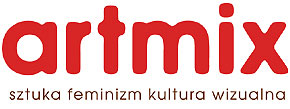
Re: Re: Re: Re: Re: Subversive Repetition and Its Consequences
"What is this 'distancing' that Brecht turned into a maxim for the actor's performance? It is the display - within the play - of the gap between the play and the real. More profoundly, it is a technique that dismantles the intimate and necessary links joining the real to semblance - links resulting from the fact that semblance is the true situating principle of the real, that which localizes and renders visible the brutal effects of the real's contingency."
(Alain Badiou)
A superficial look at the series of the prefixes "re-" in the title of Sandra Sterle's exhibition might see them as an evocation of endless repetitions/replications of the same. However, here we are dealing with an open equation in which each "re-", as well as the space in-between, is just a sign whose reference field is changeable, as the subtext of this exhibition is precisely the multiple possibilities of the performance of meaning and its consequences. However, this does not imply a simple confirmation of postmodernist postulates of a non-existing point of reference or an objective truth, nor is it a carefree staging of the freedom of seriality, accidental relations, reinterpretations, or citations. This openness, the impossibility of controlling the multiplying relations between and the signifier and the signified, action and reaction, original and copy, already evokes, in the title of the exhibition, a certain anxiety provoked by the immeasurability of the world of hyper-production, fast communication, and consummation. The question this exhibition seeks to answer is how to approach the exhibition/structural presentation of one's own work in the context of a gallery, without accepting the safety of the illusion of autonomy offered by the white cube. Rather, the exhibition questions the sources and consequences of one's own work in the complex socio-political reality.
Re: retrospective
The original Latin meaning of the prefix "re-" evokes going back and/or repeating. The multiplication of meaning already takes place at this level because repetition is never simply a one-way return to the source, in the sense which, for example, Plato defines recollection as a cognitive process that absorbs one fixed source. On the contrary, contemporary philosophy and psychoanalytic theory establish a concept of repetition which implies a kind of backward movement which, paradoxically, is a trigger for the creation of ways forward towards new possibilities and meanings. Thus, Gilles Deleuze does not interpret Nietzsche's concept of "eternal recurrence" as a regressive process but as one that actually bears a transformative potential. Judith Butler, in her feminist, performative theory of gender, presents the idea of "subversive repetition" - the strategic repetition of conventional gender patterns which, at the same time, questions or cancels them. We can interpret Sandra Sterle's artistic practise by following this paradigm, but it is essential to point out that this strategy is not only reflected in the interpretation of individual works, but in the whole concept of the exhibition, which could itself be read as a single artwork. Thus, the exhibition "repeats" the format of a retrospective by subverting its conventions. Instead of presenting the works as separate unities, frozen in the time of their creation which defines their context, the retrospective - of which the curator is the artist herself - radically disturbs the autonomy of the individual works of art, as well as the autonomy of artistic practise in general. It literally marks the author's "view in retrospect", exposing the impossibility of a neutral view. Some of her works are therefore dislocated from the original context, cut out and edited in combination with other works, and in some cases works by other artists are presented - artists who created works in reply to, or as a "consequence" of, the artist's performances.
Re: circle
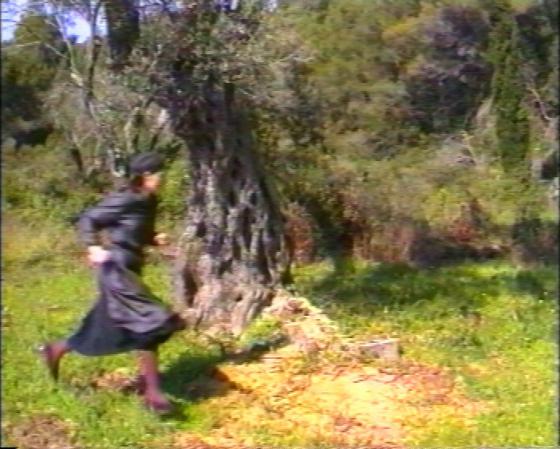
Round Around, video performance 7', 1996/97
This year, Sandra Sterle staged the video performance Round Around for the third time. The first performance took place in 1996/97. It is connected with a series of photographs in which we "find" the artist, disguised as a rural island woman, in seemingly documentary scenes of "natural" and everyday environments. The staged mimicry of the ethnographic representation of "healthy country life" is additionally emphasised by blush applied to the artist's face and by creating pastoral and idealized scenes. In the video-performance, the artist assumes the same character who we now see in slow-motion, running around an olive tree until she collapses and "disappears" behind the trunk. The artist repeated the same performance, planning to do so every seven years throughout the rest of her life, whereas only the centre of the circle (kind of the tree) changes, as well as video-technology due to the accelerated process of technologic obsoleteness. Insisting on the repeated masquerade, additionally emphasised by the metaphor of circling, is the "repetition" of the process of social inscription of gender and gender identity, exposed here precisely by the choice of "natural" environment and its "endemic" vegetation as setting. By obsessively repeating the circling around the spot which generates the fiction of "innateness" and of the biological determination of gender and gender roles, the artist "describes" gender identity as a circle; it is possible to identify and subvert it, but never entirely leave the mechanisms of identification themselves.

Round Around 2, video performance 5', 2003
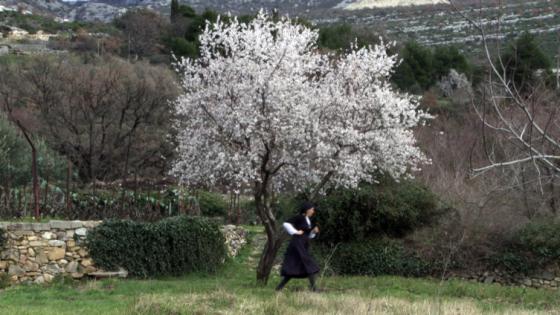
Round Around 3, video performance 5', 2010
Re: symbolization
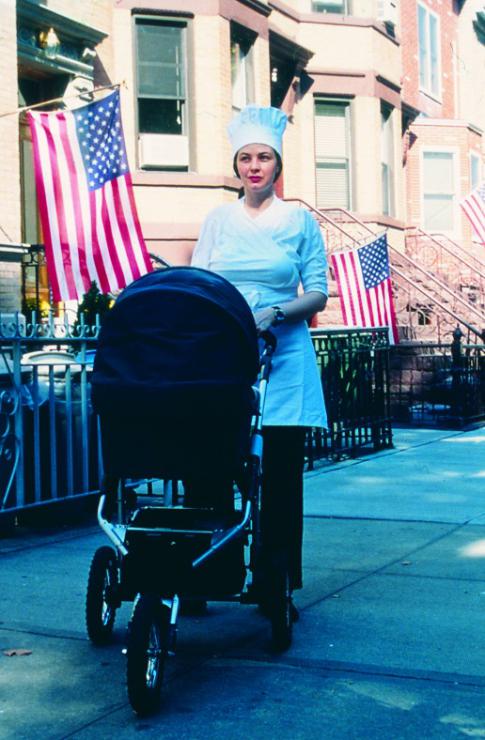
New York Diary, photography, 2001
Putting together fragments of several different works into an assemblage, the exhibition unifies another continued strategy of disguise in Sandra Sterle's work - the mimicry of national identity and belonging to a particular economic and political entity. In each of her "united" works the artist uses the symbol of the national flag. In Go Home (2001), disguised as a cook/housewife with a pram, Sterle walks along the streets of New York several days after September 11, when the whole city is covered with US flags. In Integrations or - Who Wants to Play? (2005), we can see her in the guise of a clown standing in front of the European Union flag, while in her most recent video she is running in the snow in Moscow, with the Russian flag in the background. Regardless of the characters she impersonates in the individual works, the flag itself functions as a primary mask. As in the work Round Around, the flags are symbolic centres of the circles of identity construction under which a subject finds herself accidentally, but always brought by force into the process of (re)constitution and the modification of identity.
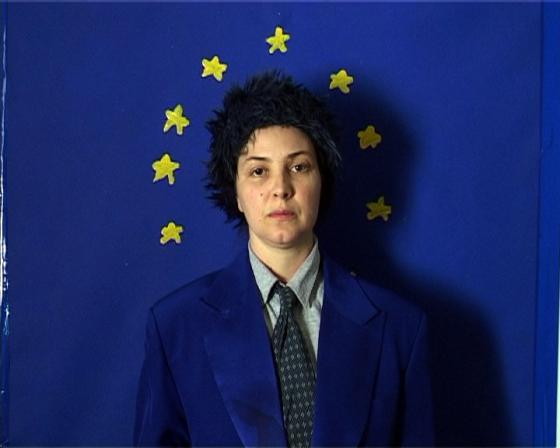
Integration, video-installation, 2001

Dream,video loop, 2010
Re: trauma, regurgitation
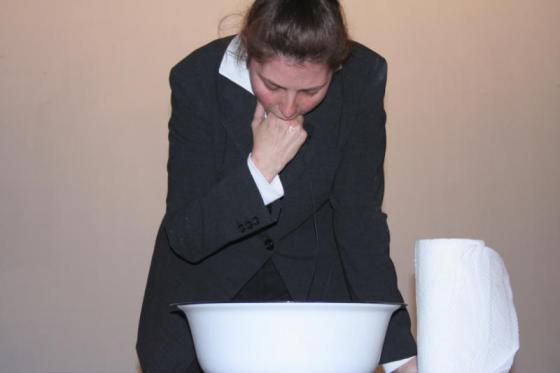
Nausea - Mučnina, performance, 2008 (DOPUST)
It is indicative that Sandra Sterle decides on more explicit body art performances when her work is not mediated but performed live in front of an audience, in rituals that in a way represent the author's own - as well as collective - encounter with the place of social trauma (even when it is the performance itself which locates it as traumatic in the first place). In the performance Nausea (2008), the artist stages acts of regurgitation accompanied by the song "Dalmatinac nosi lančić oko vrata / A Dalmatian Wears a Chain around His Neck" by Mišo Kovač, the repetition of which again represents a staged encounter with the symbolic frame, or with what Lacan terms the "complex": internalized social structure that the subject repeatedly and compulsively re-performs. The song itself symbolises the persistence of the Dalmatian provincial patriarchal heritage contained in the formula of a sacred and unbreakable tie of "blood and soil" in which, however, the female subject is invisible or merely implicated. Publicly expressing a nausea caused by oppressive social norms, the artist constitutes herself as a rebel-subject whose resistance, however, is neither verbal nor anchored in Language, but in what Julia Kristeva defines as "abjection", meaning that which precedes the constitution of the subject, its material expression being "non-articulated" body secretions.

The Orange Dog and Other Tales - Even Better Than the Real Thing, performance, 2009
Numerous "repetitions" of the performance through numerous "scandalized" reactions in the media and Internet forums were followed by its artistic re-enactment in the work The Orange Dog and Other Tales - Even Better Than the Real Thing, an "art history play" by the curatorial collective KONTEJNER in which actors restaged a number of selected performances, thus creating a staged history of Croatian performance art. Sandra Sterle's performance, in the re-enactment by Vesna Sorić-Proljeće, lost its original evocation of the heaviness and "inexpressibility" of nausea, becoming an almost carnivalesque and exhibitionist identification with the bodily process of regurgitation. The original, "unsuccessful" act of Sandra Sterle's regurgitation left the audience with an experience of nausea as an unfinished process, while the ease of its re-enactment left a feeling of catharsis which suppressed, however, the very source of nausea and thus turned into the very opposite of the original performance. The effect of the conjoined presentation of these two performances in the exhibition not only points out the reaction or echo of the artist's work but opens up the idea of authorship and its exposure to risk. In addition, this dual performance indicates uniqueness and, at the same time, the predisposed "failure" of any performance because the encounter with the real and the traumatic can be staged only as a series of "repeated" performances and therefore this encounter can never really take place.
Re: descent
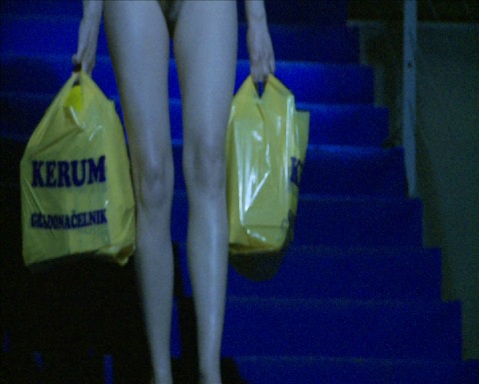
New Path to the Waterfall, performance 2009. (DOPUST)

New Path to the Waterfall, performance 2009. (DOPUST)
The performance New Path to the Waterfall (2009) was created in a similar key. This time the artist is disguised as Duchamp's "nude descending a staircase". The effect of the "estrangement" and disintegration of the female nude which Duchamp created using the cubist methods of painting is achieved by Sterle with stroboscopic effects which illuminate her nude body descending the stairs, carrying heaps of books in plastic bags which are inscribed with "Kerum for mayor". The bags were part of the then election campaign of the businessman Željko Kerum. This campaign completely exposed the state of democracy "with the Croats", where in the end political programmes boil down to an extreme populism without any content, served in a plastic bag at the supermarket. Sterle literally fills these bags with content, taking over the political campaign device as an artistic device for standing against a politics that systematically deprives art and culture of any social value whatsoever. Once again the media reactions have proven that what society finds scandalous is not this kind of politics, but the naked female body, which is again construed as an abject object jeopardizing the existing order. At the same time, the reactions of other citizens have confirmed the power of the oppositional appropriation of the political propaganda symbols in this performance. Thus an unknown artist "dressed" the statue of Marko Marulić in the Kerum plastic bags, and the Torcida football fans covered the city square Peristil using the same tactic, expressing their disapproval of the mayor's intervention in the management of their football club. Thus, the original performance surpassed the world-of-art frame, becoming an empowering initiator of civil disobedience.
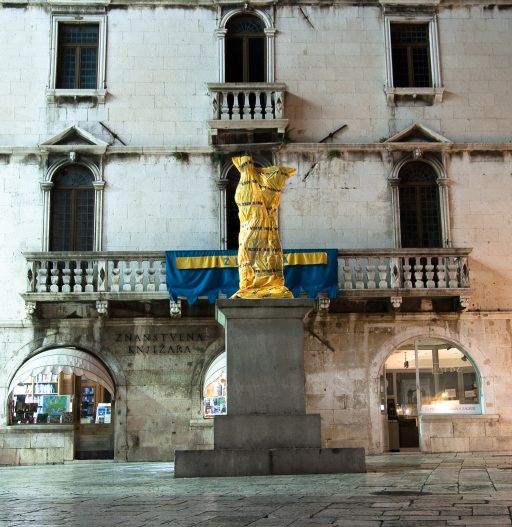
Unknown Author, Split, 2009
Re: search
For the exhibition opening, the artist has conceived of a performance which in a way represents a recapitulation of her own work while at the same time deviating from it into a space that opens new and undefined paths of its development and interpretation. This deviation also happens physically: a group of art students individually take the visitors outside the exhibition space and into the MKC darkened amphitheatre. In reversed hierarchical roles, students become the guides of the performance at the opening of their professor's retrospective, and the whole performance is dedicated to the recently deceased artist, Nan Hoover, whose student Sandra Sterle used to be. The guides, dressed in black and white suits that personify various characters (angel, punker, etc.), take visitors along the darkened stage, lighting certain parts of the space by flashlights and thus creating a script for a play, which simultaneously searches for a past event, constructs an event "in progress" and develops a play with an unpredictable ending. The performance interweaves a range of quotes and references: the strategy of disguise in Sterle's work, Nan Hoover's obsession with light, the students' work, based on which the guide characters have been created and Nan Hoover's performance in Zagreb, in which she led the audience around darkened bushes using a flashlight. It is not possible to fully identify all the quotes and references; they become interwoven, pointing out that artistic practise is not a transcendental or isolated activity of an individualised author-genius, but embodied, engendered social practise which reflects complex intersubjective and social relations while participating in their creation.

True Stories (story 1), video, ‘4.50, 1998
Finally, this performance irresistibly evokes another work by Sandra Sterle, the video True Stories (1998). Although not included in the ‘retrospective', its structure, could serve as a basis for interpretation of the whole Re: Re: Re: Re: Re: exhibition project. In the video, assuming the character of Minnie Mouse, the artist takes an unknown collocutor to the woods to show them a "secret", always revealed as a new riddle, a gap which simultaneously initiates an endless field of narratives cancelling out the opposition between reality and fiction. This gap is at the same time the only possible target of the search, which is, according to Jennifer Allen, a "search for the lost totality", implied by every repetition, recollection, or repeated performance. Thus, in the end, Re: Re: Re: Re: Re: becomes one of the possible formulae for the searching, constantly re-examining, rereading and repeatedly performing of art which - as stated in the renowned, yet insufficiently emphasised, postulate by Mladen Stilinovic - "always has consequences".
Ivana Bago
March 2010

